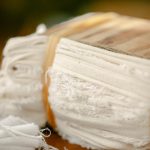You’ll find duchess satin made from silk, polyester, or blends, offering a smooth, buttery texture with a rich, glossy sheen that catches light beautifully. It’s a heavyweight, durable fabric with a structured drape, perfect for elegant gowns and formalwear. Its tightly woven finish guarantees opacity and strength, making your garments look opulent while lasting long. If you want to understand its unique qualities and how to care for it best, there’s plenty more to explore.
Table of Contents
Key Takeaways
- Duchess satin is a tightly woven, medium to heavy-weight fabric made from silk, polyester, or blends, offering durability and a structured drape.
- It features a smooth, buttery texture with a rich, lustrous sheen that enhances formalwear’s opulent appearance.
- The fabric is highly durable, resistant to wear, and maintains its elegant look over time without losing structure.
- Commonly used for evening gowns, bridal dresses, and tuxedo lapels due to its glamorous sheen and firm drape.
- Proper care includes gentle cleaning, storing on padded hangers away from sunlight, and avoiding moisture and rough surfaces to preserve texture.
What Is Duchess Satin Made Of?
Duchess satin is a luxurious fabric primarily made from silk or polyester fibers.
When you choose silk duchess satin, you get a natural fiber known for its sheen, strength, and smooth texture.
Polyester versions, on the other hand, offer durability and affordability while still mimicking silk’s glossy look.
Sometimes, manufacturers blend these fibers to balance cost and performance.
The blend also affects the fabric’s weight, drape, and feel, so it’s good to check the fiber content before buying.
Whether silk or polyester, duchess satin undergoes a specific weaving technique that contributes to its richness and smooth surface.
Knowing these fiber details helps you decide if duchess satin fits your project’s needs, whether for elegant gowns or upscale upholstery.
Key Physical Characteristics of Duchess Satin
The luxurious feel and striking appearance of this fabric come from its key physical characteristics.
The fabric’s luxurious feel and striking look stem from its distinctive physical qualities.
When you handle Duchess Satin, you’ll notice its substantial weight and firmness, giving it a structured drape that holds shape beautifully. Its tightly woven construction creates a smooth, crisp surface, making it resistant to wrinkles and creases.
You’ll also appreciate its excellent opacity, ensuring your garments remain modest without needing extra layers. The fabric’s durability means it withstands wear well, making it ideal for formal attire.
While it has a firm hand, Duchess Satin still offers enough flexibility for comfortable movement.
These physical traits combine to make this fabric perfect when you want elegance paired with lasting quality and a refined silhouette.
The Luxurious Texture and Sheen Explained
A rich, lustrous surface sets this fabric apart, drawing your eye with its unmistakable sheen. When you touch duchess satin, you’ll notice its smooth, almost buttery texture that feels indulgent against your skin.
This fabric’s weave creates a reflective surface, enhancing its glossy finish and giving it that signature opulent look. The subtle sheen isn’t overly shiny but glows softly under light, making it perfect for formalwear or elegant decor.
You’ll appreciate how its texture holds shape beautifully, adding structure without stiffness. This balance between softness and firmness gives duchess satin a tactile richness that’s both inviting and luxurious, making it stand out from other satin types.
When you choose duchess satin, you embrace sophistication in every thread.
Durability and Weight of Duchess Satin
While the luxurious texture and sheen capture your attention, you’ll also want to contemplate how this fabric performs regarding durability and weight. Duchess satin is known for its substantial weight, which gives it structure and a rich feel. It’s heavier than typical satin, making it ideal when you need fabric that holds shape without compromising elegance. Durability-wise, it’s strong and resistant to tearing, thanks to its dense weave and high-quality fibers.
| Aspect | Characteristics |
|---|---|
| Weight | Medium to heavy; supports structure |
| Durability | High; resistant to wear and tear |
| Feel | Firm yet smooth; luxurious texture |
This balance guarantees duchess satin stands up well over time while maintaining its signature look.
Common Uses in Fashion and Design
You’ll find duchess satin is a top choice for evening wear because of its rich texture and elegant sheen.
It’s especially popular in bridal gowns and formalwear, where a luxurious look is a must.
Let’s explore how designers use this fabric to create stunning, sophisticated pieces.
Evening Wear Applications
Because of its luxurious sheen and structured drape, duchess satin has become a favorite for evening wear designers aiming to create elegant, statement-making gowns.
When you choose duchess satin, you get fabric that holds shape beautifully, allowing for dramatic silhouettes and intricate detailing. It’s perfect for ball gowns, cocktail dresses, and sleek sheath designs that demand a polished finish.
The fabric’s smooth surface reflects light, enhancing the garment’s allure under evening lighting. You’ll find duchess satin ideal if you want your outfit to stand out with both sophistication and structure, especially at galas or upscale events.
Its durability also means your dress maintains its pristine look throughout the night, making it a reliable choice for your next evening wear project.
Bridal and Formalwear
Although duchess satin is often celebrated for evening wear, it truly shines in bridal and formalwear designs.
You’ll love how its smooth, lustrous surface adds an elegant touch to wedding gowns and prom dresses. The fabric’s structured weight helps create voluminous skirts and sharp silhouettes, giving you that timeless, sophisticated look.
Its durability guarantees your dress holds up throughout the big day without losing shape or sheen. Plus, duchess satin’s subtle sheen catches the light beautifully, making every movement graceful and eye-catching.
You can use duchess satin for:
- Ball gowns with dramatic full skirts
- Sleek fitted mermaid dresses
- Elegant A-line bridal gowns
- Structured peplum tops
- Classic formal tuxedo lapels
It’s a perfect choice when you want glamour and structure combined.
Tips for Sewing and Caring for Duchess Satin
When working with Duchess satin, you’ll want the right tools like sharp needles and fine thread to get clean seams.
Using careful stitching techniques helps prevent puckering and keeps your fabric smooth.
To keep your creation looking its best, follow proper cleaning and storage methods to maintain its shine and texture.
Essential Sewing Tools
Mastering the art of sewing Duchess satin starts with having the right tools at your fingertips. This luxurious fabric demands precision and care, so equipping yourself properly makes all the difference.
You’ll want tools that handle delicate textures without causing snags or damage. Here’s what you should have ready:
- Sharp, fine sewing needles to prevent fabric runs
- A walking foot to guarantee smooth fabric feeding
- Fine silk or polyester thread matching the fabric color
- Straight pins with small heads to avoid visible holes
- A pressing cloth to protect the satin while ironing
With these essentials, you’ll maintain the fabric’s integrity and achieve professional results.
Stitching Techniques
Having the right tools in hand makes stitching Duchess satin much smoother, but knowing the proper techniques will help you achieve clean seams and prevent damage.
Use sharp, fine needles (size 60/8 or 70/10) to avoid snagging the fabric. Opt for a straight stitch with a shorter stitch length to create secure seams without puckering. Pin carefully and sparingly to prevent permanent holes; consider using fabric clips instead.
Press seams gently with a low heat iron and a pressing cloth to protect the satin’s sheen. When handling seams, avoid stretching the fabric to maintain its shape and smooth finish.
Finally, practice patience—Duchess satin’s dense weave demands precision, but your careful stitching will guarantee a polished, professional-looking garment.
Cleaning and Storage
Although Duchess satin is luxurious and durable, it requires careful cleaning and storage to maintain its lustrous appearance. You should always handle it gently to avoid crushing the fabric’s smooth surface.
When cleaning, avoid harsh detergents and opt for dry cleaning or spot cleaning with mild soap and cold water. For storage, keep it in a cool, dry place away from direct sunlight to prevent fading and yellowing. Hang your satin garments on padded hangers to preserve their shape and avoid creases.
- Use a gentle dry-cleaning service
- Spot clean stains immediately with cold water
- Avoid wringing or twisting the fabric
- Store in breathable garment bags
- Keep away from moisture and direct sunlight
Following these tips helps your Duchess satin look its best over time.
Frequently Asked Questions
Can Duchess Satin Be Recycled or Is It Environmentally Friendly?
You can recycle duchess satin, but it depends on the fiber content—natural fibers recycle easier than synthetics. It’s not always environmentally friendly, so you should check the material’s specifics and opt for sustainable choices when possible.
How Does Duchess Satin Compare to Other Satin Fabrics in Cost?
Duchess satin usually costs more than regular satin because it’s thicker, heavier, and more luxurious. If you’re looking for durability and elegance, it’s worth the higher price compared to lighter, less expensive satin fabrics.
Are There Any Hypoallergenic Benefits to Wearing Duchess Satin?
You might expect all silky fabrics to cause irritation, but duchess satin’s smooth weave reduces friction and allergens. While it’s not fully hypoallergenic, it’s gentler on sensitive skin than rougher textiles you might encounter.
What Historical Era Popularized Duchess Satin Fabric?
You’ll find duchess satin became popular during the Victorian era, known for its luxurious sheen and heavy weight. It was favored in high society for elegant gowns and bridal wear, symbolizing wealth and sophistication.
Can Duchess Satin Be Dyed at Home Successfully?
You can dye duchess satin at home, but it’s tricky since it’s a dense, often synthetic blend. You’ll need fabric-specific dye, careful temperature control, and patience to achieve even, vibrant colors without damaging the fabric’s sheen.
- Review: The A&I 200 Thread Count 100% Cotton Percale Sheet Set - July 14, 2025
- How to Soften Percale Sheets: Tips and Tricks From Reddit Users - July 14, 2025
- Is 200 Thread Count Cotton Percale Good? A Quality Analysis - July 14, 2025







